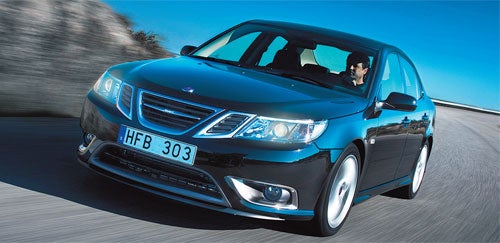'Jätta bra!': It's Swedish for power plus grip
With its new four-wheel drive Turbo X, Saab has overcome its road-holding problems and beaten the Germans at their own game

Early turbocharged Saabs had a bad rep. A combination of catch-you-with-your-knickers-down turbo power delivery and front wheels that had about the same level of grip as Walter Mitty had on reality made driving one feel like you were trying to tame Bucephalus*. It was like wrestling with an angry stoat. Or being jogged by your friends while writing something at school. Or ... you know, all wriggly.
These days, though, Saabs – some of them, anyway – come with four-wheel drive, and one, the new Turbo X (£32,495), also comes with electronic LSD. Far from being, as you might suspect, something prescribed by Jimi Hendrix's chemist, eLSD is an active limited slip differential. Together with an intelligent four-wheel drive system, it helps makes the X, or Malcolm as it's known to its friends, feel unbelievably planted. There is no wheel spin, no stomach-churning slide on roundabouts and not a smidgen of torque steer (the car spod's term for the stoat-wrestling I tried to describe earlier). In the dry, at least, there is nothing you can do to make this car lose its grip. In fact, I found that the muscles in my sides cried submission way before the tyres came remotely close to losing adhesion, although that probably says as much about my physical decrepitude as the car.
Peter Johansson from Haldex, the company that developed the system, tried to explain it to me but lost me shortly after, "You know how a normal differential works ..." (Don't worry; the press information is more helpful: "The eLSD, located alongside the RDM, operates on the same principle as the larger TTD.") Another bit of electronics, the Power Take Off Unit, is clearly meant to evoke Saab's aeronautical history, and works well. An aggressive standing start felt like being in one of those pull-back-and-go toy cars – there was no spooling-up of power, no scrabbling for grip, just point, press and go. Jätta bra! as they say in Sweden.
As German manufacturers continue to play at their absurd horsepower one-upmanship, with engine outputs routinely topping 500bhp, the Swedes make do with a mere 280bhp. In truth, it is all you will ever really need – the thing catapults to 60mph in 5.4 seconds, for heaven's sake. Anything else is just a licence loser these days.
The only trouble is that the Turbo's performance writes cheques the interior quality can't cash. Most of it is pure, sub-£20k 9-3, which means there are some brittle, cheap plastics, lightweight stalks and coarse-grained leather of the kind found in mid-range US saloons. Oh, and there is something else. Every time you start up, a sign flashes up on the instrument display saying "Ready for Take-off". Oh deary me.
Outside, I pulled another face at the brash, optional 19in "titanium effect" wheels, the Buck Rogers-style exhaust pipes and the great chinny front spoiler. On a Saab, it's all somehow mildly unsettling – as if Huw Edwards had got piercings and a tattoo.
But that's nit-pickery. They aim to sell 500 Turbo Xs in the UK. Do I think it will find that many buyers? Course you can, Malcolm.
* Buce-phalus was the name of Alexander the Great's horse, by the way. And before you ask – yes, I did have to go and look it up.
Join our commenting forum
Join thought-provoking conversations, follow other Independent readers and see their replies
Comments
Bookmark popover
Removed from bookmarks